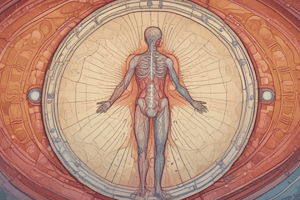Podcast
Questions and Answers
What is the estimated incidence of hypoparathyroid disease in the United States?
What is the estimated incidence of hypoparathyroid disease in the United States?
- 1 case in 1,000 persons
- 4 cases in 100,000 persons (correct)
- 1 case in 10,000 persons
- 12 cases in 10,000 persons
What is the most common cause of hypoparathyroid disease?
What is the most common cause of hypoparathyroid disease?
- Thyroid surgery (correct)
- Autoimmune disorders
- Genetic mutations
- Vitamin D deficiency
What is a serious acute complication of hypoparathyroidism?
What is a serious acute complication of hypoparathyroidism?
- Hypertension
- Diabetes mellitus
- Osteoporosis
- Laryngeal spasms (correct)
What is the result of subnormal secretions of parathyroid hormone (PTH) into the blood?
What is the result of subnormal secretions of parathyroid hormone (PTH) into the blood?
What is the frequency of postoperatively induced hypoparathyroid disease after repeated neck explorations?
What is the frequency of postoperatively induced hypoparathyroid disease after repeated neck explorations?
What is the prevalence of hypoparathyroid disease in the United States?
What is the prevalence of hypoparathyroid disease in the United States?
What is a characteristic of hypoparathyroid disease?
What is a characteristic of hypoparathyroid disease?
What is a clinical symptom of hypoparathyroidism?
What is a clinical symptom of hypoparathyroidism?
What is the most common cause of iatrogenic hypoparathyroidism?
What is the most common cause of iatrogenic hypoparathyroidism?
What is the average age for development of symptoms related to autoimmune induced hypoparathyroidism?
What is the average age for development of symptoms related to autoimmune induced hypoparathyroidism?
What percentage of patients become hypoparathyroid after transplantation of a fraction of one of the parathyroid glands cryopreserved during surgery?
What percentage of patients become hypoparathyroid after transplantation of a fraction of one of the parathyroid glands cryopreserved during surgery?
What is the consequence of autoimmune induced hypoparathyroid disease?
What is the consequence of autoimmune induced hypoparathyroid disease?
What is a congenital cause of hypoparathyroidism?
What is a congenital cause of hypoparathyroidism?
What is the consequence of not receiving calcium therapy for hypoparathyroid disease?
What is the consequence of not receiving calcium therapy for hypoparathyroid disease?
What is a type of congenital hypoparathyroidism?
What is a type of congenital hypoparathyroidism?
Who published a list of specific conditions that cause hypoparathyroidism?
Who published a list of specific conditions that cause hypoparathyroidism?
Which of the following conditions is characterized by copper overload?
Which of the following conditions is characterized by copper overload?
What is the effect of low serum magnesium levels on PTH secretion?
What is the effect of low serum magnesium levels on PTH secretion?
What is the result of PTH stimulating the activity of renal 1-α-hydroxylase?
What is the result of PTH stimulating the activity of renal 1-α-hydroxylase?
What is the effect of PTH on osteoclasts?
What is the effect of PTH on osteoclasts?
What is the result of PTH inhibiting the reabsorption of phosphate by renal proximal tubules?
What is the result of PTH inhibiting the reabsorption of phosphate by renal proximal tubules?
Which of the following is an example of infiltration-related hypoparathyroidism?
Which of the following is an example of infiltration-related hypoparathyroidism?
What is the effect of PTH on serum calcium levels?
What is the effect of PTH on serum calcium levels?
Which of the following is a reversible cause of hypoparathyroidism?
Which of the following is a reversible cause of hypoparathyroidism?
What is the primary goal of therapy for hypocalcemia?
What is the primary goal of therapy for hypocalcemia?
How often should serum calcium levels be monitored?
How often should serum calcium levels be monitored?
What is the recommended target for urine calcium levels?
What is the recommended target for urine calcium levels?
What is the recommended diet for patients with hypocalcemia?
What is the recommended diet for patients with hypocalcemia?
What is the mainstay of treatment for hypocalcemia?
What is the mainstay of treatment for hypocalcemia?
What is the purpose of vitamin D therapy in hypocalcemia?
What is the purpose of vitamin D therapy in hypocalcemia?
What is the advantage of ergocalciferol over other vitamin D preparations?
What is the advantage of ergocalciferol over other vitamin D preparations?
What is the purpose of intravenous calcium gluconate in hypocalcemia?
What is the purpose of intravenous calcium gluconate in hypocalcemia?
Which of the following symptoms is NOT a common complaint of patients with hypoparathyroidism?
Which of the following symptoms is NOT a common complaint of patients with hypoparathyroidism?
What is the purpose of inflating a blood pressure cuff to a pressure 20 mm Hg above the systolic blood pressure for 3-5 minutes during a physical examination?
What is the purpose of inflating a blood pressure cuff to a pressure 20 mm Hg above the systolic blood pressure for 3-5 minutes during a physical examination?
What is the significance of a prolonged QT interval on the electrocardiogram in patients with hypoparathyroid disease?
What is the significance of a prolonged QT interval on the electrocardiogram in patients with hypoparathyroid disease?
What is the most serious acute complication of hypoparathyroid disease?
What is the most serious acute complication of hypoparathyroid disease?
What is the outcome of chronic hypoparathyroidism in children?
What is the outcome of chronic hypoparathyroidism in children?
What is the prognosis for patients with hypoparathyroid disease if diagnosed and treated promptly?
What is the prognosis for patients with hypoparathyroid disease if diagnosed and treated promptly?
What is the significance of basal ganglia calcifications observed with computed tomography (CT) scans of the skull?
What is the significance of basal ganglia calcifications observed with computed tomography (CT) scans of the skull?
What is the significance of cataract formation observed with slit-lamp examination of the eyes?
What is the significance of cataract formation observed with slit-lamp examination of the eyes?
Flashcards are hidden until you start studying
Study Notes
Hypoparathyroid Disease
- Hypoparathyroid disease is an endocrine disorder characterized by subnormal secretions of parathyroid hormone (PTH) into the blood, resulting in low levels of serum calcium.
- The condition can be congenital or acquired, either permanent or temporary.
Prevalence
- The overall incidence of hypoparathyroid disease is approximately 4 cases in 100,000 persons in the United States, with a prevalence of around 12,000 Americans.
- Postoperative-induced hypoparathyroid disease occurs in approximately 1% of all individuals who undergo thyroid surgery, increasing to 10% after repeated neck explorations.
Significance
- The significance of hypoparathyroidism lies primarily in its clinical symptoms and complications, including tetany, laryngeal and bronchial spasms, and tonic-clonic seizures.
- Without calcium therapy, patients can die from these complications.
Causes and Risk Factors
- Causes of hypoparathyroid disease can be classified as iatrogenic (treatment-induced), autoimmune, congenital, metal overload-induced, infiltration-related, and hypomagnesemia-induced.
- The most common cause is surgical excision of parathyroid gland tissue in the treatment of thyroid, parathyroid, laryngeal, or other diseases of the neck.
- Autoimmune polyglandular syndrome type 1 is one cause of autoimmune disease within parathyroid tissue, with an average age of development of symptoms at 7 years.
Pathophysiology
- Parathyroid hormone has four major physiologic effects to elevate serum calcium levels:
- Activates osteoclasts to break down bone and release ionized calcium into the blood.
- Inhibits phosphate reabsorption by renal proximal tubules, increasing phosphate excretion and serum calcium concentration.
- Increases calcium reabsorption in renal distal tubules.
- Stimulates the activity of renal 1-α-hydroxylase, a critical enzyme in the synthesis of 1,25-dihydroxyvitamin D.
Diagnosis
- Patients with hypoparathyroidism often complain of symptoms such as paresthesias, twitching and painful muscle spasms, lethargy, anxiety, hyperirritability, mood swings, thin and brittle nails, dry and scaly skin, and hair loss.
- Clinical signs of hypocalemia include positive Chvostek sign, positive Trousseau sign, prolongation of the QT interval on the electrocardiogram, basal ganglia calcifications, and cataract formation.
Serious Complications and Prognosis
- Serious complications include tetany, convulsions, and respiratory tract obstruction leading to asphyxiation.
- Chronic hypoparathyroidism can cause cataracts, Parkinson-like symptoms in adults, and defective teeth and bone development and mental retardation in children.
- The outlook for recovery is good if diagnosis and treatment are prompt, with patients expected to live a near-normal life.
Treatment
- The primary goal of therapy is to maintain serum calcium concentration in a slightly low but mild asymptomatic range (8.0–8.6 mg/dL) to minimize hypercalciuria and prevent hypercalcemia.
- Monitoring serum calcium levels at least every 3 months is mandatory, with urine calcium levels maintained below 30 mg/dL if possible.
- A diet rich in calcium is recommended, with magnesium supplementation instituted when the disorder is caused by magnesium deficiency.
- Calcium and vitamin D are the mainstays of treatment, with intravenous calcium gluconate often given slowly until tetany remits, followed by oral calcium and vitamin D therapy.
Studying That Suits You
Use AI to generate personalized quizzes and flashcards to suit your learning preferences.




